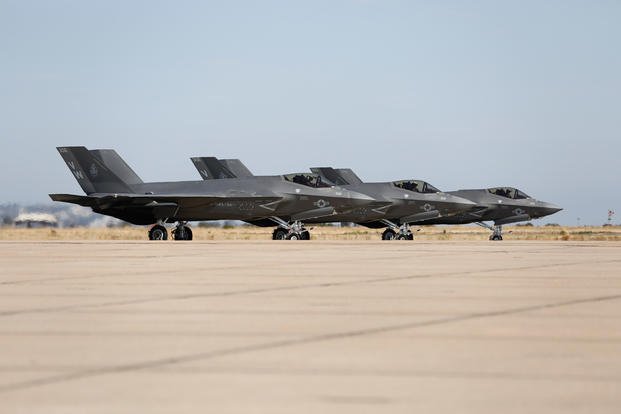While the U.S. Marine Corps says its first squadron of F-35 Joint Strike Fighters is fully equipped and ready for war, the Air Force and Navy need more time to catch up.
With a carrier deployment anticipated sometime next year, Marine Fighter Attack Squadron (VMFA) 314 of Marine Corps Air Station Miramar, California, said earlier this month that its fifth-generation F-35C jets have achieved full operational capability, known as FOC -- meaning they're ready for full operations.
Experts believe that could be because the Marine Corps chose to buy far fewer of the C aircraft than the Navy and Air Force purchased of their variants, letting the Marine Corps reach the operational breakthrough faster.
Read Next: Study Finds Beard Waivers Slow Promotion, Mostly Affecting Black Airmen
While the Marine Corps has not disclosed how many F-35Cs the squadron has now, the service plans to buy 67 F-35Cs at most for use on carriers, according to the 2019 USMC Aviation Plan. The Air Force, meanwhile, has a projected buy of 1,763 jets, and the Navy 273 of its carrier-capable Cs. The Marine Corps also plans to buy 353 F-35B short takeoff and vertical landing models.
"It speaks to the more limited roles the Marines expect to use the plane for," said a congressional staffer with longtime knowledge of military aviation. The staffer asked not to be identified because they are not authorized to speak to the press.
"The Marines now have enough experience with the jet to understand what it can and can't do and how they have to operate it," they said, adding that it doesn't mean there are no bugs or fixes that still need to be taken care of.
All the jet variants are awaiting the latest update to the F-35's avionics and weapons systems, upgrades that began in 2018. The update is meant to expand the type of weapons the aircraft can carry, among other improvements.
"There are still all kinds of kinks to be worked out even after FOC," said Richard Aboulafia, vice president and analyst at the Teal Group, referring to the upgrade. "But at least this is a significant milestone on the road to readiness, and perhaps even maturity."
How the Navy and Air Force stack up
The Marine Corps has been first to reach a number of F-35 milestones, but unlike the F-35C variant, its sibling F-35B model has yet to be deemed fully ready for combat.
The service's F-35B was first to achieve basic certification in 2015, which means the plane can fly patrols and conduct basic strikes but not more advanced missions, ahead of the Navy and Air Force. In 2018, the F-35B made its combat debut, conducting its first strike in Afghanistan.
But each service sets its own requirements for declaring their aircraft operational based on a number of factors, including the level of training personnel receive and the number of squadrons flying the aircraft.
The Air Force is not expected to declare full capability for its F-35A conventional take-off and landing jet until two combat bases are fully operational with the appropriate amount of trained personnel, said Air Combat Command spokeswoman Alexi Worley in an email last week. Those two bases in this case are Hill Air Force Base, Utah and Eielson Air Force Base, Alaska.
Worley said that the Air Force will wait until Eielson joins Hill in both having its F-35s on hand and getting its personnel fully trained to take care of the aircraft before the service declares the planes are fully operational.
Eielson only began accepting F-35s last year. The 354th Fighter Wing accepted its first two Lightning II aircraft last April, and have built up to 25 jets since then. A total of 54 are scheduled to arrive by December 2021. Hill, meanwhile, has 78 jets.
"At this point, we don't have an exact timeline for when those requirements will be met and that declaration will happen," Worley said.
The Navy only has one deployable F-35C squadron -- Strike Fighter Squadron 147 "Argonauts" out of Naval Air Station Lemoore, California. The Navy's other F-35C squadron, Strike Fighter Squadron 125, a training squadron, is also out of Lemoore.
The Argonauts will deploy with the Carl Vinson Carrier Strike Group later this summer, Cmdr. Zach Harrell, spokesperson for Commander, Naval Air Forces, said in an email Monday. The unit is anticipated to be fully ready for combat "as planned within the next four years," he said.
Marine Fighter Attack Squadron 314 nevertheless is proud of its recent fulfillment.
-- Oriana Pawlyk can be reached at oriana.pawlyk@military.com. Follow her on Twitter at @Oriana0214.
Related: Marine Corps' First Carrier-Capable F-35 Squadron Is Ready for Wartime Use













